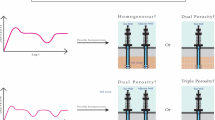Abstract
Transient rate decline curve analysis for constant pressure production is presented in this paper for a naturally fractured reservoir. This approach is based on exponential and constant bottom-hole pressure solution. Based on this method, when ln (flow rate) is plotted versus time, two straight lines are obtained which can be used for estimating different parameters of a naturally fractured reservoir. Parameters such as storage capacity ratio (ω), reservoir drainage area (A), reservoir shape factor (C A ), fracture permeability (k f ), interporosity flow parameter (λ) and the other parameters can be determined by this approach. The equations are based on a model originally presented by Warren and Root and extended by Da Prat et al. and Mavor and Cinco-Ley. The proposed method has been developed to be used for naturally fractured reservoirs with different geometries. This method does not involve the use of any chart and by using the pseudo steady state flow regime, the influence of wellbore storage on the value of the parameters obtained from this technique is negligible. In this technique, all the parameters can be obtained directly while in conventional approaches like type curve matching method, parameters such as ω and λ should be obtained by other methods like build-up test analysis and this is one of the most important advantages of this method that could save time during reservoir analyses. Different simulated and field examples were used for testing the proposed technique. Comparison between the obtained results by this approach and the results of type curve matching method shows a high performance of decline curves in well testing.
Similar content being viewed by others
References Cited
Abbasi, M., Hossieni, M., Izadmehr, M., et al., 2016. Tracer Transport in Naturally Fractured Reservoirs: Analytical Solutions for a System of Parallel Fractures. International Journal of Heat and Mass Transfer, 103(2016): 627–634. doi:10.1016/j.ijheatmasstransfer.2016.07.078
Abramowitz, M., Stegun, I. A., 1972. Handbook of Mathematical Functions. Dover Publications Inc., New York
Bona, N., Radaelli, F., Ortenzi, A., et al., 2003. Integrated Core Analysis for Fractured Reservoirs: Quantification of the Storage and Flow Capacity of Matrix, Vugs, and Fractures. SPE Reservoir Evaluation & Engineering, 6(4): 226–233. doi:10.2118/85636-pa
Bourbiaux, B., Granet, S., Landereau, P., et al., 1999. Scaling up Matrix-Fracture Transfers in Dual-Porosity Models: Theory and Application. Paper SPE-56557-MS Presented at the SPE Annual Technical Conference and Exhibition, Houston. doi:10.2118/56557-MS.
Chen, H. Y., 1985. A Reservoir Engineer Characterization of the Austin Chalk Trend: [Dissertation]. Texas A&M University, Texas
Da Prat, G., Cinco-Ley, H., Ramey, H. Jr., 1981. Decline Curve Analysis Using Type Curves for Two-Porosity Systems. Society of Petroleum Engineers Journal, 21(3): 354–362. doi:10.2118/9292-pa
de Swaan, A., 1990. Influence of Shape and Skin of Matrix-Rock Blocks on Pressure Transients in Fractured Reservoirs. SPE Formation Evaluation, 5(4): 344–352. doi:10.2118/15637-pa
Duguid, J. O., Lee, P. C. Y., 1977. Flow in Fractured Porous Media. Water Resources Research, 13(3): 558–566. doi:10.1029/wr013i003p00558
Gang, T., Kelkar, M. G., 2006. Efficient History Matching in Naturally Fractured Reservoirs. Paper SPE-99578-MS Presented at the SPE/DOE Symposium on Improved Oil Recovery, Tulsa, Oklahoma. doi:10.2118/99578-MS.
Gilman, J. R., 1986. An Efficient Finite-Difference Method for Simulating Phase Segregation in the Matrix Blocks in Double-Porosity Reservoirs. SPE Reservoir Engineering, 1(4): 403–413. doi:10.2118/12271-pa
Gutmanis, J., 2009. Basement Reservoirs––A Review of Their Geological and Production Characteristics. Paper IPTC-13156-MS Presented in International Petroleum Technology Conference, Doha, Qatar. doi:10.2523/IPTC-13156-MS
Igbokoyi, A. O., Tiab, D., 2006. Estimation of Average Reservoir Pressure and Drainage Area in Naturally Fractured Reservoirs––Tiab’s Direct Synthesis. SPE-104060-MS Presented at the First International Oil Conference and Exhibition in Mexico, Cancun. 1–13. doi:10.2118/104060-MS
Landereau, P., Noetinger, B., Quintard, M., 2001. Quasi-Steady Two-Equation Models for Diffusive Transport in Fractured Porous Media: Large-Scale Properties for Densely Fractured Systems. Advances in Water Resources, 24(8): 863–876. doi:10.1016/s0309-1708(01)00015-x
Mavor, M. J., Cinco-Ley, H., 1979. Transient Pressure Behavior of Naturally Fractured Reservoirs. Paper SPE-7977-MS Presented at the SPE California Regional Meeting, Houston. 18–20. doi:10.2118/7977-MS
Noetinger, B., Estebenet, T., 2000. Up-Scaling of Double Porosity Fractured Media Using Continuous-Time Random Walks Methods. Transport in Porous Media, 39: 315–337. doi:10.1023/A:1006639025910
Pruess, K., 1985. A Practical Method for Modeling Fluid and Heat Flow in Fractured Porous Media. Society of Petroleum Engineers Journal, 25(1): 14–26. doi:10.2118/10509-pa
Saidi, M. A., 1987. Reservoir Engineering of Fractured Reservoirs. Total Edition Press, Paris. 289
Stehfest, H., 1970. Algorithm 368: Numerical Inversion of Laplace Transforms [D5]. Communications of the ACM, 13(1): 47–49. doi:10.1145/361953.361969
Tiab, D., 1994. Analysis of Pressure Derivative without Type-Curve Matching: Vertically Fractured Wells in Closed System. Journal of Petroleum Science and Engineering, 11: 323–333
Tiab, D., 1995. Analysis of Pressure and Pressure Derivative without Type-Curve Matching, Skin and Wellbore Storage. Journal of Petroleum Science and Engineering, 12: 171–181
Tiab, D., Igbokoyi, A., Restrepo, D., 2007. Fracture Porosity from Pressure Transient Data. International Petroleum Conference, Bratislava. 8. doi:10.2523/IPTC-11164-MS.
van Everdingen, A. F., Hurst, W., 1949. The Application of the Laplace Transformation to Flow Problems in Reservoirs. Journal of Petroleum Technology, 1(12): 305–324. doi:10.2118/949305-g
Warren, J. E., Root, P. J., 1963. The Behavior of Naturally Fractured Reservoirs. Society of Petroleum Engineers Journal, 3(3): 245–255. doi:10.2118/426-pa
Acknowledgment
Thanks go to the reviewers and the editors for their helpful suggestions. The final publication is available at Springer via https://doi.org/10.1007/s12583-017-0776-y.
Author information
Authors and Affiliations
Corresponding authors
Rights and permissions
About this article
Cite this article
Daryasafar, A., Joukar, M., Fathinasab, M. et al. Estimating the properties of naturally fractured reservoirs using rate transient decline curve analysis. J. Earth Sci. 28, 848–856 (2017). https://doi.org/10.1007/s12583-017-0776-y
Received:
Accepted:
Published:
Issue Date:
DOI: https://doi.org/10.1007/s12583-017-0776-y




